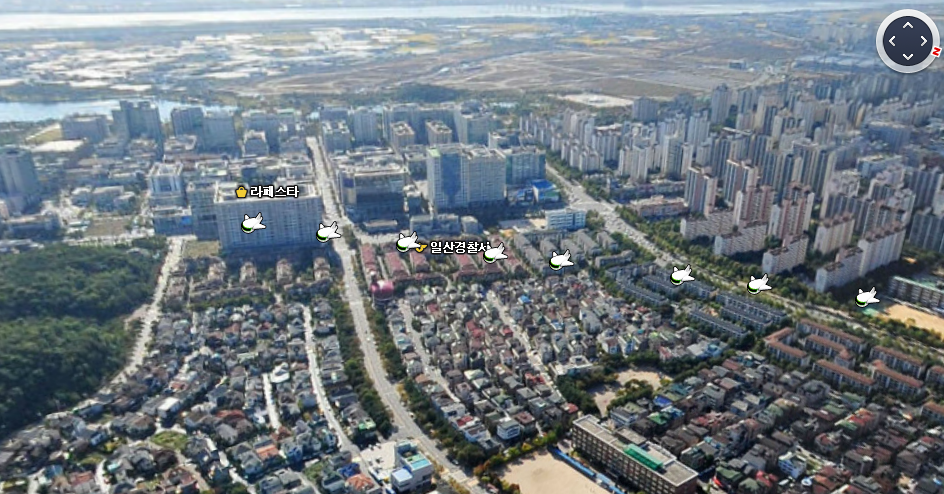Early on Sunday, I took a picture of Ilsan’s “suburbs”. (Ilsan is a city northwest of Seoul. I lived there for one year and was back visiting.) Here is the view I had from the tenth floor:

East-Central Ilsan, looking east
Most of Ilsan’s residents, along with most residents of the Seoul Megalopolis generally, live in buildings similar to those in the background (monolithic highrise apartments). A select few in Ilsan live in actual detached/single-family houses, similar to those in the foreground below (I think these foreground buildings are mixed-use, and may even be multi-family. I assure you that nearby are thousands of smallish single-family houses, though). They have no yard space. A few feet separate the wall of one house from the wall of the next. Most are relatively small by U.S. standards, and sell for $1 million, I’m told.
In the center-left of the photo above is a building with a South-Korean flag on one side and a U.S. flag on the other. It is the “Korea Christian International School” (한국기독국제학교), which I’d never heard of till now. The existence of such a school is testament to the strength of Christianity in Ilsan, and in South-Korea generally. Actually, it’s hard for me to imagine a “Korea Buddhist International School” in Ilsan. If there were one, it wouldn’t be so conspicuous or “self-confident”, I’d imagine. Buddhism is so lethargic/undynamic in Ilsan as to be near invisible, in my experience.
Here’s a (3D model) view from near the same spot, but looking west. You can see a lot of small single-family homes.

3D Model of central Ilsan from Naver Maps.
Single-family houses in the foreground, “downtown” in the center, apartments on the right, the Han River far in the background
A few minutes’ walk from even the remotest of these “suburban houses” allows a resident to find a bus-stop to elsewhere in Ilsan or to Seoul, or to a train station to enter the region’s huge urban rail network. Korea thus has nothing like American suburbs, of course. Some people call Ilsan itself a “suburb”, which is mostly wrong. It may be a bedroom community for Seoul to an extent, but it’s not a suburb at all in the American sense. It’s proper designation is “new city” (신도시). The “new cities” in South Korea are just transplants (onto former farmland) of high-end Seoul, just better-planned and better laid-out.
In my first year in Korea, when I lived in Ilsan, I had a student named Lee H.J., who lived in one of those houses in central Ilsan, I somehow learned. Many of the students were a bit spoiled, but H.J. was particularly bad. She was smart and worked pretty hard, but her attitude was persistently gloomy and usually hostile. She complained almost every day. I started to realize that “heavy is the head that wears the crown”. Being brought up wealthy in South Korea must seem like nothing but a punishment. She went to four or five after-school institutes, and was the object of constant pressure from her mom. If she were poorer, she wouldn’t have been so burdened by all that extra studying.
Lee H.J. (who was in 6th and 7th grade when I taught her in 2009-2010) provided me with a memorable line I’ve pondered ever since. She wrote, “Today is only tomorrow’s yesterday.” She wrote it in an essay. What does it mean? It seems like it could/should have some deep meaning, but when I try to grab onto that meaning, it always conceptually slips through my fingers, like trying to grab onto a cloud.



http://blog.naver.com/ssceoss/220494626377
Greetings indeed to you ,I read your greatly searched review abt Ilsan City in Korea. Wudnt you read and have more info abt newly built plans within ilsan downtown ? it is commonly referred as Hallyu World 한류월드. Many thanks to you, for your interest on ILSAN city. Im also an occupant of ilsan, living in here since 2003.
It’d be pleasure to know regarding you.
Sincerely yours, Sanz .
E-mail: ssceoss@naver.com
Futher contacts ‘re written above, wanting you to reply.
the sooner the better !